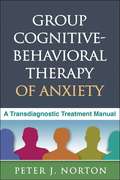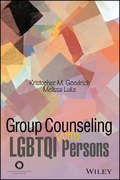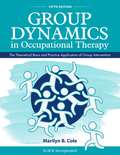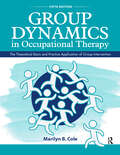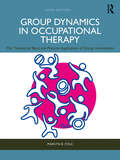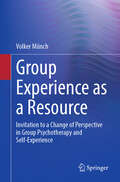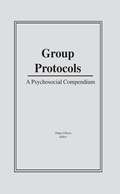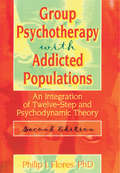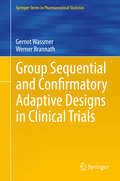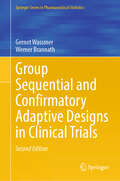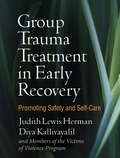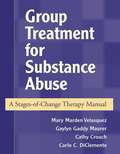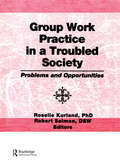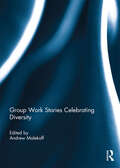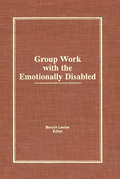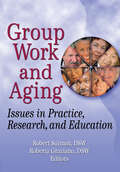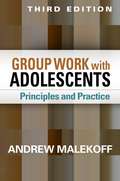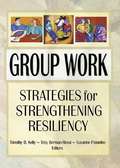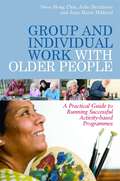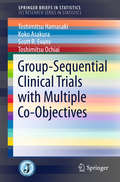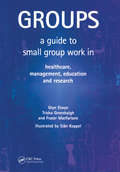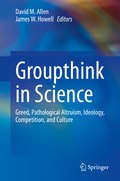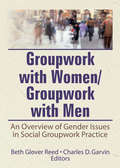- Table View
- List View
Group Cognitive-Behavioral Therapy of Anxiety
by Peter J. NortonCognitive-behavioral therapy is highly effective in the treatment of anxiety disorders, regardless of the specific type of fear that is causing difficulties. This practical, hands-on clinical resource presents a proven group treatment protocol for patients with any anxiety diagnosis. Step-by-step guidelines are provided for setting up transdiagnostic groups, using comprehensive assessment to plan and monitor treatment, and implementing carefully sequenced cognitive and behavioral techniques. Clinical examples illustrate the nuts and bolts of intervention across different anxiety disorder presentations. Special features include 19 reproducible handouts and forms that can be downloaded and printed in a convenient 8 1/2" x 11" size.
Group Counseling with LGBTQI Persons Across the Life Span
by Kristopher Goodrich Melissa LukeThis unique resource provides strengths-based, group counseling strategies designed to meet the needs of LGBTQI clients in a variety of settings. Drs. Goodrich and Luke capture the developmental concerns of LGBTQI individuals throughout the life cycle as they establish and maintain intimate relationships, create families, encounter career concerns, and navigate other milestones and transitions. Illustrative case examples and interventions throughout the text, as well as warnings and recommendations, make this an ideal resource for practice and group work courses. After a discussion of the history of group work with the LGBTQI community, the planning and process issues that group leaders should consider in their work, and relevant ethical and legal concerns, the authors explore a range of group types and pertinent issues. Individual chapters focus on the following types of counseling: child and adolescent; same-gender adult; intersex and transgender; coming out/disclosure; school, community outpatient, and residential; couples and family; substance abuse; grief and loss; and advocacy. Chapters on group work supervision and the importance of allies round out the book. *Requests for digital versions from the ACA can be found on wiley.com. *To request print copies, please visit the ACA website here. *Reproduction requests for material from books published by ACA should be directed to permissions@counseling.org.
Group Dynamics In Occupational Therapy: The Theoretical Basis and Practice Application of Group Intervention
by Marilyn ColeThe theory section clarifies how occupation based models and frames of reference change the way occupational therapy groups are organized and how theory impacts the selection of group activities, goals, and outcomes. Recent examples and evidence are added in this Fifth Edition to reflect the design and use of groups for evaluation and intervention within the newly evolving paradigm of occupational therapy.
Group Dynamics in Occupational Therapy: The Theoretical Basis and Practice Application of Group Intervention
by Marilyn B. ColeIn occupational therapy practice, well designed groups represent social and cultural contexts for occupational performance in everyday life. Group Dynamics in Occupational Therapy: The Theoretical Basis and Practice Application of Group Intervention, the best-selling text for over 25 years by Marilyn B. Cole, has been updated to a Fifth Edition, offering strategies and learning tools to place clients in effective groups for enhanced therapeutic interventions. Updated to meet the AOTA’s Occupational Therapy Practice Framework, Third Edition, this Fifth Edition provides guidelines for occupational therapy group design and leadership and guides application of theory-based groups. The theory section clarifies how occupation based models and frames of reference change the way occupational therapy groups are organized and how theory impacts the selection of group activities, goals, and outcomes. Recent examples and evidence are added in this Fifth Edition to reflect the design and use of groups for evaluation and intervention within the newly evolving paradigm of occupational therapy. The third section focuses on the design of group protocols and outlines a series of group experiences for students. These are intended to provide both personal and professional growth, as well as a format for practice in group leadership, self-reflection, cultural competence, and community service learning. A new chapter focusing on the recovery model and trauma-informed care suggests ways for occupational therapists to design group interventions within these broadly defined approaches. Cole’s 7-step format for occupational therapy group leadership provides a concrete, user-friendly learning experience for students to design and lead theory based groups. The settings for which students can design group interventions has been updated to include current and emerging practice settings. Included with the text are online supplemental materials for faculty use in the classroom. With a client-centered theoretical approach, Group Dynamics in Occupational Therapy: The Theoretical Basis and Practice Application of Group Intervention, Fifth Edition continues a 25-year tradition of education for occupational therapy and occupational therapy assistant students and clinicians.
Group Dynamics in Occupational Therapy: The Theoretical Basis and Practice Application of Group Intervention
by Marilyn B. ColeThis best-selling textbook, now in its Sixth Edition, provides the essential strategies and tools that occupational therapists need to design and organize client groups for enhanced, theory-based therapeutic interventions for physical, mental health, and wellness populations.Updated in line with AOTA’s latest Occupational Therapy Practice Framework, the book is split into three sections. Section I introduces author Marilyn Cole’s 7-step format for group leadership, the cornerstone for the rest of the book. This is followed by chapters on the fundamentals of group dynamics, client-centered groups, and issues around diversity, inclusion, and cultural humility. Section II provides an overview of a range of theoretical approaches to group work, from psychodynamic, biomechanical, behavioral/cognitive, developmental, sensory, and occupation-based models.Section III focuses on design of group protocols, synthesizing the theories, activities or modalities, leadership, and membership selection guidelines. Revisions include guidelines for using a client-centered group approach with marginalized populations, as well as designing occupational therapy groups with wellness and non-traditional populations for student service learning in the community.Thoroughly updated throughout, and with new case studies drawn from a range of disciplines, this is an essential resource for any student or practitioner in the field of occupational therapy.
Group Experience as a Resource: Invitation to a Change of Perspective in Group Psychotherapy and Self-Experience
by Volker MünchThis textbook for psychotherapists and group therapists encourages the reader to reflect on their own group experiences throughout their life journey and to relate these insights to therapy processes. Psychological life and personal development always occur within networks. Analytical group therapy utilizes this and makes psychological processes visible that often remain unclear in individual treatments. Our understanding of human psychological development is transforming in light of neuroscientific findings and against the backdrop of the complex societal challenges of our time, evolving into a view of humans as social animals. We are witnessing a resurgence in group therapy and an openness to theories that emphasize our mutual dependence in a positive sense. Togetherness and solidarity can thus be practiced collectively, unleashing transformative power for change in individuals, but also for society. Many relatable examples, especially from therapeutic groups, illustrate this. Written for: Psychotherapists, group therapists, group leaders in the medical and social fields. About the Author: Dipl. Psych. Volker Münch, Psychological Psychotherapist in private practice in Munich. Teaching analyst, supervisor, and lecturer at MAP, Munich. Publications on topics such as therapeutic attitude, digitalization, and midlife crisis.
Group Process and Structure in Psychosocial Occupational Therapy
by Diane GibsonEffective group leadership techniques are the focus of this practical, sound volume. Dedicated to assisting occupational therapy practitioners and students in understanding current theory and state-of-the-art techniques in group treatment, this functional book fills the gap left by existing literature and educational programs that focus mainly on diagnoses and task analysis. Highly skilled professionals examine the important concepts of group therapy--structural elements, such as goals, norms, group size, physical environment, and instructions that can be varied depending on the purpose, needs, and functional level of the client; the ability to guide and control process elements, such as spontaneous feedback; and the ability to support clients and help build a cohesive, safe group. Fascinating examples of innovative new group techniques--social skills game, mime group, and the use of robots--demonstrate how creative content can effectively combine structure and process in group treatment.
Group Protocols: A Psychosocial Compendium
by Diane GibsonHere is a valuable book intended to help those occupational therapists working in mental health settings to refine their critical thinking about the group activities they select and the protocols they design. Experts focus on practicing sound clinical reasoning and clinical decision making to ensure careful assessment of which activities, structured in what fashion, are appropriate for particular populations. They also address the topic of providing services that are relevant, practical, have already delineated goals and objectives, produce outcome data, and can be replicated across settings. Group Protocols: A Psychosocial Compendium offers readers a systematic approach to the assessment and design of group protocols, plus a wide variety of sample protocols from which treatment strategies may be drawn. Because this volume represents a style of thinking rather than a singular theoretical frame of reference, it will be useful to any occupational therapist for whom groups are an essential aspect of professional practice.
Group Psychotherapy with Addicted Populations: An Integration of Twelve-Step and Psychodynamic Theory, Second Edition
by Bruce Carruth Philip FloresIn this newly revised edition, Philip J. Flores, a highly regarded expert in the treatment of alcoholism and in group psychotherapy, provides you with proven strategies for defeating alcohol and drug addiction through group psychotherapy. For the first time, practical applications of 12-step programs and (ital) psychodynamic groups are jointly explored, jointly explained, and jointly brought into therapeutic use. You'll examine the constructive benefits of group therapy to chemically dependent individuals--opportunities to share and identify with others who are going through similar problems, to understand their own attitudes about addiction by confronting similar attitudes in others, and to learn to communicate their needs and feelings more directly.Group Psychotherapy with Addicted Populations covers the key areas of group psychotherapy for chemically dependent persons including:alcoholism, addiction, and psychodynamic theories of addictionalcoholics anonymous and group psychotherapyuse of confrontational techniques in the groupinpatient group psychotherapycharacteristics of the leadertransference in the groupresistance in groupspreparing the chemically dependent person for groupthe curative process in group therapy Along with his powerful chapters that emphasize the positive and constructive opportunities group psychotherapy brings to the chemically dependent individual, Flores has added these new sections:integrating a modern analytic approacha discussion of object relations theorygroup psychotherapy, AA, and twelve-step programsdiagnosis and addiction treatmenttreatment issues at early, middle, and late stages of treatmenta discussion of guidelines and priorities for group leaderscountertransferencespecial considerations of resistance to addictiontermination of treatmentThose working in group therapy will find this expanded second edition a valuable resource for better recognizing and serving their group members’needs, and they will feel a sense of fulfillment as Flores reaffirms the positive effects of group psychotherapy.
Group Sequential and Confirmatory Adaptive Designs in Clinical Trials
by Gernot Wassmer Werner BrannathThis book provides an up-to-date review of the general principles of andtechniques for confirmatory adaptive designs. Confirmatory adaptive designs area generalization of group sequential designs. With these designs, interimanalyses are performed in order to stop the trial prematurely undercontrol of the Type I error rate. In adaptive designs, it is also permissibleto perform a data-driven change of relevant aspects of the study design atinterim stages. This includes, for example, a sample-size reassessment, atreatment-arm selection or a selection of a pre-specified sub-population. Essentially, this adaptive methodology was introduced in the 1990s. Since then, it has become popular and the object of intense discussion andstill represents a rapidly growing field of statistical research. This bookdescribes adaptive design methodology at an elementary level, while alsoconsidering designing and planning issues as well as methods for analyzing anadaptively planned trial. This includes estimation methods and methods for thedetermination of an overall p-value. Part I of the book provides the groupsequential methods that are necessary for understanding and applying theadaptive design methodology supplied in Parts II and III of the book. The bookcontains many examples that illustrate use of the methods for practicalapplication. The book is primarily written for applied statisticians from academiaand industry who are interested in confirmatory adaptive designs. It is assumedthat readers are familiar with the basic principles of descriptive statistics,parameter estimation and statistical testing. This book will also be suitablefor an advanced statistical course for applied statisticians or clinicians witha sound statistical background.
Group Sequential and Confirmatory Adaptive Designs in Clinical Trials (Springer Series in Pharmaceutical Statistics)
by Gernot Wassmer Werner BrannathThis book provides an up-to-date review of the general principles and techniques of confirmatory adaptive designs, a generalization of group sequential designs. With these designs, interim analyses are performed in order to stop a trial prematurely under control of the Type I error rate. In adaptive designs, it is also permissible to perform a data-driven change of relevant aspects of the study design at interim stages. This includes, for example, a sample-size reassessment, a treatment-arm selection, or a selection of a pre-specified sub-population.First introduced in the 1990s, this popular adaptive methodology has become the focus of intense discussion and is still a rapidly growing field of statistical research. The book describes adaptive design methodology at an elementary level, while also considering design and planning issues. It also looks at methods for analyzing an adaptively planned trial, such as estimation methods and methods for determining an overall p-value. Part I provides the group sequential preliminaries required to understand and apply the adaptive design methodology supplied in Parts II and III. Many examples are included that illustrate the practical applications of the techniques. An overview of recent developments is given and, new to this edition, detailed descriptions of the R commands used for the calculations are provided. The R package rpact, which is available on CRAN, allows for the recalculation of most tables and results presented in the monograph. The required knowledge of R has been kept to a minimum, and an online Shiny app has been made available for rpact. Primarily written for applied statisticians from academia and industry who are interested in confirmatory adaptive designs, the text is also suitable for an advanced statistical course for applied statisticians or clinicians with a sound statistical background.
Group Trauma Treatment in Early Recovery: Promoting Safety and Self-Care
by Judith Lewis Herman Diya Kallivayalil and Members of the Victims of Violence ProgramInfused with clinical wisdom, this book describes a supportive group treatment approach for survivors just beginning to come to terms with the impact of interpersonal trauma. Focusing on establishing safety, stability, and self-care, the Trauma Information Group (TIG) is a Stage 1 approach within Judith Herman's influential stage model of treatment. Vivid sample transcripts illustrate ways to help group participants deepen their understanding of trauma, build new coping skills, and develop increased compassion for themselves and for one another. In a large-size format for easy photocopying, the volume provides everything needed to implement the TIG, including session-by-session guidelines and extensive reproducible handouts and worksheets. Purchasers get access to a companion website where they can download and print the reproducible materials from the book, as well as an online-only set of handouts and worksheets in Spanish. See also The Trauma Recovery Group, by Michaela Mendelsohn, Judith Lewis Herman, et al., which presents a Stage 2 treatment approach for clients who are ready to work on processing and integrating traumatic memories.
Group Treatment for Substance Abuse
by Gaylyn Maurer Mary VelasquezThis practical manual presents a 29-session treatment program designed to engage, motivate, and stimulate processes of change in clients at all stages of recovery. The program is based on the research-supported transtheoretical model of behavior change. The manual describes skills-building activities and interventions that are likely to be most effective with clients as they cycle from the earlier stages of change precontemplation, contemplation, and preparation to the later stages, action and maintenance. Each of the structured sessions is presented in a consistent, highly accessible format, including a clear rationale, summary of objectives, and overview of the main activities that will take place. Step-by-step guidelines for implementation are provided, as well as strategies for using a motivational interviewing style. The manual is complete with all needed handouts and exercise forms, ready to photocopy and distribute to clients. Ideal for use with groups, the approach can easily be adapted to individual treatment.
Group Work Practice in a Troubled Society: Problems and Opportunities
by Robert Salmon Roselle KurlandThis book presents the wide range and diversity of effective group work practice in today’s troubled society. Representing the best in current practice, chapters discuss modern group work and contain rich examples of practice and theory. Group Work Practice in a Troubled Society examines the social realities in which group work is now practiced and addresses present-day social issues and problems.Contributing authors to Group Work Practice in a Troubled Society discuss innovations in practice, programs, and theory, and a wide variety of work with clients in many different settings. There is a breadth and strength and diversity in contemporary group work practice, and the authors--practitioners and educators from the United States, Canada, and Hong Kong--represent the vitality of current practice and theory. Among the many topics they discuss are: contextual group work practice latent content in work with groups group work in administration cultural sensitivity and diversity in small-group practice group work in other cultures and with immigrant populations feminist group work and unique considerations in work with women’s groups group work with sexually abused children, with incest survivors, and with sexual offenders group work in community centers group work with mentally ill chemical abusers group work use in an innovative 12-step modalityGroup Work Practice in a Troubled Society provides a wealth of information and ideas for social workers and students of social work who are interested or involved in group work and who wish to learn more about current practice and developments in the field.
Group Work Stories Celebrating Diversity
by Andrew MalekoffGroup Work Stories Celebrating Diversity is a most timely book about group work practice and education that highlights the theme of diversity, which encompasses acceptance and respect for various dimensions of difference. Dimensions of diversity include race, ethnicity, gender, sexual orientation, socio-economic status, age, physical or intellectual abilities, linguistic difference, religious beliefs, international or regional origin, lifestyle, political beliefs, or other ideologies, as well as the varying and complex intersection of these various dimensions. The thirty-one meaningful stories in this book explore these differences, leading to understanding and to moving beyond simple tolerance to mutual empathy, genuine and open encounter, and the celebration of the rich dimensions of diversity. Readers will enjoy this wonderfully intimate and intriguing collection, and will be moved to share them with others to help to spread the word about the importance of embracing, understanding and celebrating diversity. This book, with an international cast of authors – practitioners, educators and students – is a welcome antidote to the divisiveness and suspicion that swirl around difference and have become a sad hallmark of current times. This book was originally published as a special issue of the Social Work with Groups journal.
Group Work With the Emotionally Disabled
by Baruch LevineHere is an exciting and informative volume on the use of social group work in psychiatric settings. As it affirms the significance of social group work’s clinical potential, Group Work With the Emotionally Disabled fosters further development in this highly specialized area of human service.Baruch Levine, a prestigious social group worker and clinical theorist, has edited this exceptional volume that emphasizes the coexistence of mental illness and mental health in effective group experiences for treating mental disability. Readers are treated to a comprehensive history of the development of the use of social group work practice with the emotionally disabled in psychiatric settings. Other authoritative chapters focus on the practice aspect and explore the problems and issues in group work with the emotionally disabled, the settings for group treatment of the chronically ill and psychiatrically at-risk, and the development of comprehensive approaches to the treatment and rehabilitation of persons with severe mental illness.
Group Work and Aging: Issues in Practice, Research, and Education
by Robert Salmon Roberta K GrazianoGet a wealth of information about the theory and practice of social work with older adults, their families, and their caregivers!Although there is a considerable amount of writing on both group work and social work with the elderly, there is surprisingly little about applying this practice method to this specific age group. Group Work and Aging: Issues in Practice, Research, and Education fills this gap by presenting penetrating articles about a mutual aid approach to working with diverse groups of older adults with varied needs. Respected experts and gifted researchers provide case studies, practice examples, and explanation of theory to illustrate this practice method with aging adults, their families, and their caregivers.Group Work and Aging: Issues in Practice, Research, and Education discusses in-depth information on group work with gay and lesbian elders, caregivers, elders with Alzheimer&’s disease, service providers, special populations such as Vietnamese and Latino/a elders, and provides information on the use of expressive therapies like art, drama, and dance. Each well-referenced chapter presents high quality, up-to-date social group work practice strategies to prepare practitioners for the needs of the growing population of elderly in the near future.Group Work and Aging: Issues in Practice, Research, and Education discusses: the adaptation of group work practice approaches when working with older group members the use of a Record of Service as an analytical tool in group work with aging lesbians a chronicle of a student&’s field placement at a drop-in center for homeless senior citizens the sociocultural reality of the Asian immigrant elderly residential substance abuse treatment for older adults mutual aid groups for older persons with mental illness the relationship between caregiver support groups and the marker framework of family caregiving telephone caregiver support groups group work interventions with elderly parents of adults with severe mental illness a program for the development and implementation of an intergenerational singing group support groups as an effective therapy at end-of-life the use of a mutual aid group with home attendants and much more!Group Work and Aging: Issues in Practice, Research, and Education reveals the latest examples of good group work practice with aging adults and their support systems, perfect for practitioners, educators, and anyone interested in and/or work with older adults.
Group Work with Adolescents, Third Edition
by Andrew MalekoffA trusted course text and professional resource, this comprehensive book delves into all aspects of planning and conducting strengths-based group work with adolescents. In an accessible, down-to-earth style, Andrew Malekoff spells out the principles of effective group practice. Extensive clinical illustrations show how successful group leaders engage teens in addressing tough issues--including violence, sexuality, prejudice, social isolation, and substance abuse--in a wide range of settings. Normative issues that adolescents face in the multiple contexts of their lives are lucidly explained. Packed with creative ideas and activities, the book helps readers develop their skills as confident, reflective practitioners. New to This Edition *Significantly revised chapters on group work essentials, school-based practice, and trauma. *Additional topics: social media and cyberbullying, expressive and animal-assisted therapies, mindfulness, adolescent brain development, and more. *Updated practice principles, information, and references. *Numerous new practice illustrations.
Group Work: Strategies for Strengthening Resiliency
by Timothy B. Kelly Toby Berman-Rossi Susanne PalomboExplore the latest research and practice information in group work!Group Work: Strategies for Strengthening Resiliency is a collection of research and information presented at the Twentieth Annual International Symposium on Social Work with Groups. Resiliency issues are explored in relation to children, couples, managers, survivors of torture, poor women, HIV/AIDS affected youth, and other population groups. The contributors were keynote speakers and paper presenters at the symposium. They represent a wide range of fields of practice and experience.For social workers, students, educators, and practitioners, this volume examines how group work can improve resiliency in your community. Here's a sample of what you'll find inside: Keynote Speaker Jeremy Woodcock's experiences in his groundbreaking resiliency work with victims of torture Alex Gitterman's brilliant exposition of the notions of resiliency and vulnerability--he outlines the current thinking and puts it into a group work context case examples that illustrate resiliency in children a discussion of how residential settings can function like a 24-hour group and how to use that group effectively to strengthen the resiliency of the residents a way to use groups to help develop social and economic capital for poor women through investment clubs group themes and practice strategies for group work with couples who have differing HIV statusGroup Work: Strategies for Strengthening Resiliency also contains chapters reflecting the personal experiences of the authors. One shares her transformation from a worker who did case work in a group into a social group worker. Another shares a reminiscence of a personal journey during her formative years as a budding group worker.From its description of how the use of group work principles and skills can benefit managers and programs to its challenge to group workers to incorporate some community work skills into their repertoire, Group Work: Strategies for Strengthening Resiliency is more than a fascinating read--it is a tool to help you keep abreast of the latest theory and practice in this ever-changing field.
Group and Individual Work with Older People
by Swee Hong Chia Julie Heathcote Jane Marie HibberdBeing active is fundamental to a person's sense of physical and mental wellbeing, and the need to engage in purposeful and meaningful activity does not diminish with age. However, common effects of ageing, such as reduced vision and hearing, arthritis, dementia, and in some cases social isolation, can affect an older person's ability to participate in therapeutic and recreational activities. Introducing the concept of PIE (Planning, Implementation and Evaluation), this practical resource will enable professionals working with older people to initiate and run successful activity-based programmes with their clients, either individually or in groups. The authors guide the reader through the processes of group and individual work, and provide step-by-step instructions for a range of activities, including arts and crafts, music, drama, movement, relaxation, reminiscence, and day-to-day tasks such as taking care of personal hygiene and preparing food and drinks. The book also describes the importance of assessing and evaluating activity-based work, with examples of completed evaluation and assessment forms. Useful case studies and self-reflective activities for the facilitator are included throughout. This book will be an invaluable for occupational therapists, creative arts therapists, health and social care practitioners and all other professionals working with older people.
Group-Centered Prevention in Mental Health
by Elaine Clanton HarpineThis book presents the concept of group-centered prevention and provides explanations and exercises for learning the method and teaching it to others. Detailed studies offer evidence for the continuing importance of prevention in mental well-being and distinguishes group-centered prevention from other group interventions by its ability to resolve incipient mental health issues and emotional problems. Case examples with adults, children, couples, and others demonstrate successful uses of group-centered techniques as well as illustrate the problems that arise in group settings. The book's ready-to-apply training exercises give prospective group leaders practice in starting new groups, fostering cohesion, integrating therapeutic factors into sessions, and other core skills. Featured topics include: Group-centered prevention in contrast with other group interventions. Characteristics of effective leaders in group-centered prevention. Benefits of prevention groups as opposed to those gained in counseling and therapy. Key constructs of self-efficacy and intrinsic motivation in group-centered prevention. Stages of development in new groups. Formats for developing training exercises. Group-Centered Prevention in Mental Health is an essential resource for scientist-practitioners, clinicians, and researchers as well as graduate students in such disciplines as school psychology, social work, and public health. Its educational uses span classroom, workshop, and training settings across the health and healing disciplines.
Group-Sequential Clinical Trials with Multiple Co-Objectives
by Toshimitsu Hamasaki Koko Asakura Scott R. Evans Toshimitsu OchiaiThis book focuses on group sequential methods for clinical trials with co-primary endpoints based on the decision-making frameworks for: (1) rejecting the null hypothesis (stopping for efficacy), (2) rejecting the alternative hypothesis (stopping for futility), and (3) rejecting the null or alternative hypothesis (stopping for either futility or efficacy), where the trial is designed to evaluate whether the intervention is superior to the control on all endpoints. For assessing futility, there are two fundamental approaches, i. e. , the decision to stop for futility based on the conditional probability of rejecting the null hypothesis, and the other based on stopping boundaries using group sequential methods. In this book, the latter approach is discussed. The book also briefly deals with the group sequential methods for clinical trials designed to evaluate whether the intervention is superior to the control on at least one endpoint. In addition, the book describes sample size recalculation and the resulting effect on power and type I error rate. The book also describes group sequential strategies for three-arm clinical trials to demonstrate the non-inferiority of experimental intervention to actively control and to assess the assay sensitivity to placebo control.
Groups: A Guide to Small Group Work in Healthcare, Management, Education and Research (Evidence-based Medicine Ser. #43)
by Trisha Greenhalgh Fraser Macfarlane Glyn ElwynIn this introductory text, the author presents the law relating to child care and the reforms introduced by the Children Act 1989, assessing its impact on child care practice and procedures. Focusing on a practical interpretation of the law by the use of hypothetical examples, practice notes and recommendations, the book illustrates its relevance to those working in the caring and health professions, and incorporates details of various sets of Guidance and Regualtions issued by the Department of Health. In addition it provides an outline of adoption law, the principles of consent to treatment and the effect of surrogacy and "assisted reproduction" on the legal definition of parenthood.
Groupthink in Science: Greed, Pathological Altruism, Ideology, Competition, and Culture
by David M. Allen James W. HowellThis book discusses one of the hottest topics in science today, i.e., the concern over certain problematic practices within the scientific enterprise. It raises questions and, more importantly, begins to supply answers about one particularly widespread phenomenon that sometimes impedes scientific progress: group processes. The book looks at many problematic manifestations of “going along with the crowd” that are adopted at the expense of truth. Closely related is the concept of pathological altruism or altruism bias—the tendency of scientists to bias their research in order to further the ideological or financial interests of an “in-group” at the expense of both the interest of other groups as well as the truth. The book challenges the widespread notion that science is invariably a benevolent, benign process. It defines the scientific enterprise, in practice as opposed to in theory, as a cultural system designed to produce factual knowledge. In effect, the book offers a broad and unique take on an important and incompletely explored subject: research and academic discourse that sacrifices scientific objectivity, and perhaps even the scientist’s own ethical standards, in order to further the goals of a particular group of researchers or reinforce their shared belief system or their own interests, whether economic, ideological, or bureaucratic.
Groupwork With Women/Groupwork With Men: An Overview of Gender Issues in Social Groupwork Practice
by Charles Garvin Beth ReedThis important book focuses on the subject of gender as a factor to be considered in forming and managing groups in social work practice.
